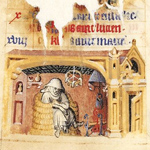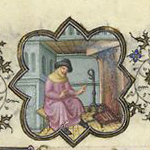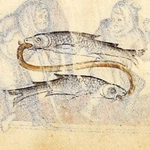Friday, October 28, 2011
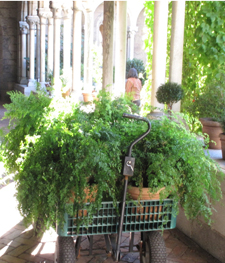
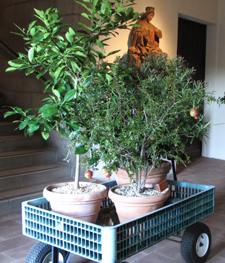
Potted plants too tender to spend the winter in Bonnefont garden are trucked inside and brought up to Cuxa cloister, which is??glazed in mid-October. Mediterranean plants such as bitter orange, myrtle, and bay laurel spend the cold season in the sunny arcades and??are brought back out to the herb garden when the glass comes down in mid-April. Left:??A wagonload of maidenhair fern in the arcade of Bonnefont garden. Right:??oranges and pomegranates en route to Cuxa cloister.?? Photographs by Carly Still
While the medieval plant collection at The Cloisters includes a good number of northern European species, a great many of the plants grown in the Bonnefont Cloister herb garden are Mediterranean in origin. Not all of these southern European plants are hardy for us here in New York City. The garden is a sheltered U.S.D.A. Hardiness Zone 7, and the fig tree (Ficus carica), poet’s jasmine (Jasminum officinale), and lavender (Lavandula angustifolia) do just fine outdoors, but more tender species like bitter orange (Citrus aurantium), rosemary (Rosmarinus officinalis), bay laurel (Laurus nobilis), and dittany of Crete (Origanum dictamnus) must be brought inside and protected from the cold. Read more »
Tags: Albertus Magnus, bay, Citrus aurantium, cucumber, cucurbit, dittany, fern, ficus carica, fig, jasmine, Jasminum officinale, laurel, Laurus nobilis, Lavandula angustifolia, Lavender, maidenhair, myrtle, orange, Origanum dictamnus, rosemary, Rosmarinus officinalis, santolina, winter
Posted in Food and Beverage Plants, Fragrant Plants, Gardening at The Cloisters, Introduction, Magical Plants, Medicinal Plants, Medieval Agriculture, Plants in Medieval Art | Comments (2)
Friday, February 19, 2010
Above, from left to right: Detail of the activity for the month from the February calendar page of ??The Hours of Jeanne d’??vreux, ca. 1324???28; detail of the activity for February from the Belles Heures of Jean de France, Duc de Berry, 1405???1408/1409; detail of the zodiacal symbol Pisces from The Hours of Jeanne d’??vreux. See the Heilbrunn Timeline of Art History to learn more about manuscript illumination in Northern Europe, or see special exhibitions for information about the exhibition “The Art of Illumination: The Limbourg Brothers and the Belles Heures of Jean de France, Duc de Berry” (on view at the Main Building March 2 through June 13, 2010).
In the medieval calendar tradition, the month of February is frequently represented by a solitary male figure seated before a fire; he may or may not be cooking his meal as he warms himself. A table set with a few dishes is sometimes placed by the fire, a variant on the theme of feasting common to both January and February. (See “The January Feast,” January 15, 2010). Read more »
Tags: Belles Heures, book of hours, calendar, February, Jeanne d?????vreux, winter
Posted in The Medieval Calendar | Comments (2)



